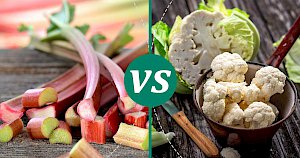Cauliflower vs Rhubarb: Nutrition, Calories & Protein Compared


Cauliflower vs Rhubarb
Nutrition Facts
Serving size:
change
5g10g15g20g30g40g50g60g80g100g120g140g160g180g200g220g250g300g350g400g450g500g600g700g800g900g1000g
1oz2oz3oz4oz5oz6oz7oz8oz10oz12oz15oz20oz25oz30oz35oz40oz50oz
Amount Per Serving:
Serving size:
change
5g10g15g20g30g40g50g60g80g100g120g140g160g180g200g220g250g300g350g400g450g500g600g700g800g900g1000g
1oz2oz3oz4oz5oz6oz7oz8oz10oz12oz15oz20oz25oz30oz35oz40oz50oz
Amount Per Serving:
Cauliflower vs Rhubarb 100g Compare
| per 100g | Cauliflower | Rhubarb |
|---|---|---|
| Calories | 25 | 21 |
| Carbohydrates | 4.97 g | 4.54 g |
| Fat | 0.28 g | 0.2 g |
| Dietary fiber | 2 g | 1.8 g |
| Protein | 1.92 g | 0.9 g |
| Calcium | 22 mg | 86 mg |
| Iron | 0.42 mg | 0.22 mg |
| Magnessium | 15 mg | 12 mg |
| Potassium | 299 mg | 288 mg |
| Sodium | 30 mg | 4 mg |
| Zink | 0.27 mg | 0.1 mg |
| Vitaminium B1 (Thiamine) | 0.05 mg | 0.02 mg |
| Vitaminium B2 (riboflavin) | 0.06 mg | 0.03 mg |
| Vitaminium B3 (Niacin) | 0.507 mg | 0.3 mg |
| Vitaminium B5 | 0.667 mg | 0.085 mg |
| Vitaminium B6 | 0.184 mg | 0.024 mg |
| Vitaminium B9 (Folic acid) | 57 mg | 7 mg |
| Vitaminium C | 48.2 mg | 8 mg |
| Vitaminium E | 0.08 mg | 0.27 mg |
| Vitaminium K | 15.5 µg | 29.3 µg |
Exploring the Wonders of Cauliflower and Rhubarb
When it comes to choosing vegetables for a balanced diet, cauliflower and rhubarb stand out for their unique flavors and nutritional profiles. Cauliflower, a cruciferous vegetable, is renowned for its versatility in the kitchen, capable of transforming into rice, pizza crusts, and even steaks. Rhubarb, on the other hand, with its tart flavor, is often mistaken as a fruit and is popularly used in pies and desserts. But beyond their culinary uses, how do these two stack up nutritionally?
A Closer Look at Nutritional Content
At first glance, both cauliflower and rhubarb boast low calorie counts, with cauliflower containing approximately 25 calories per 100 grams and rhubarb slightly lower at 21 calories. This makes them excellent choices for those monitoring their calorie intake.
When it comes to macronutrients, cauliflower provides slightly more protein and fat, with 1.92 grams of protein and 0.28 grams of fat, compared to rhubarb's 0.9 grams of protein and 0.2 grams of fat. Both vegetables are also good sources of dietary fiber, essential for digestive health.
Minerals and Vitamins Showdown
The battle gets interesting when examining the mineral and vitamin content of these two. Rhubarb takes the lead in calcium content, offering 86 mg compared to cauliflower's 22 mg. This makes rhubarb a great option for supporting bone health. However, cauliflower is not far behind with its impressive array of nutrients, including higher levels of vitamin C and vitamin K, crucial for immune health and blood clotting, respectively.
Both vegetables offer a range of B vitamins, but cauliflower provides significantly more vitamin B6 and folate (vitamin B9), which are vital for brain health and energy production. Rhubarb, however, contains more vitamin A, beneficial for vision and skin health.
What About Minerals?
In terms of minerals, both cauliflower and rhubarb contribute to a healthy diet with potassium, magnesium, and iron. Cauliflower slightly edges out rhubarb in potassium content, which is essential for heart health and muscle function. Rhubarb, however, is lower in sodium, making it a better choice for those watching their salt intake.
Conclusion: Which One Wins?
Ultimately, the choice between cauliflower and rhubarb comes down to personal preference and dietary needs. Both offer unique nutritional benefits and can be part of a healthy, balanced diet. Cauliflower might be the go-to for those looking for versatility in cooking and a boost in vitamin C, while rhubarb could be favored for its calcium content and tart flavor, perfect for desserts.
Incorporating a variety of vegetables into your diet is key to obtaining a range of nutrients, so why not enjoy both cauliflower and rhubarb? Whether you're making a savory cauliflower dish or a sweet rhubarb pie, you'll be nourishing your body with essential vitamins and minerals.
Cauliflower 100g
25kcalCalories source
- 66% CARBS.
- 26% PROTEIN
- 8% FAT
Rhubarb 100g
21kcalCalories source
- 77% CARBS
- 15% PROTEIN
- 8% FAT
Compares of cauliflower
- Cauliflower vs Artichoke
- Cauliflower vs Arugula
- Cauliflower vs Asparagus
- Cauliflower vs Beetroot
- Cauliflower vs Bitter Melon
- Cauliflower vs Bok Choy
- see all compares of cauliflower
Marcin Piotrowicz
calories-info.com creator
Healthy diet and healthy lifestyle promoter
Add comment